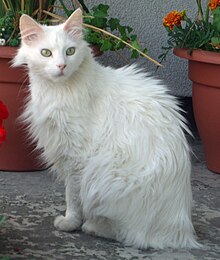Fibroblast growth factor 5
| FGF-5 | ||
|---|---|---|
| Properties of human protein | ||
| Mass / length primary structure | 251 AA | |
| Isoforms | Long, Short (106 AA) | |
| Identifier | ||
| Gene name | FGF5 | |
| External IDs | ||
| Occurrence | ||
| Parent taxon | Vertebrates | |
The fibroblast growth factor 5 ( FGF-5 , from engl. Fibroblast Growth Factor 5 ) is a signaling protein of the family of Fibroblast Growth Factors , which in vertebrates occurs.
FGF-5 is known to be responsible for hair length in mammals. Mice in which the gene has been destroyed by gene targeting have very elongated hair. The cause is an inhibiting role on hair growth during the growth phase ( anagen ). The FGF5 gene has three exons . In mice and other mammals, the protein exists in two isoforms , which are produced by alternative splicing of the same RNA transcript . The shorter of the two isoforms lacks the middle exon.
Long hair types of domestic dogs, house cats and other pets, often referred to as angora , often also carry a mutation in the FGF-5 gene. It was therefore assumed that a mutation in this gene could also be related to the long fur of the woolly mammoth . Sequence comparisons between woolly mammoths and various modern elephant forms revealed hardly any mammoth-specific peculiarities in the FGF5 gene. Only two differences in the sequence were found. One in the promoter , which, however, should not affect the binding of transcription factors and a silent mutation in Exon3, i.e. one that does not affect the protein sequence. Accordingly, the FGF5 gene does not seem to be responsible for the differences between elephants and woolly mammoths. However, a possible influence cannot be completely ruled out, since regulatory sequences that influence gene expression could be found in the introns.
supporting documents
- ↑ Homologues at OMA
- ↑ Online magazine of the University of Bern: Cats would wear short hair
- ↑ JM Hebert, T. Rosenquist, J. Gotz, GR Martin : FGF5 as a regulator of the hair growth cycle: evidence from targeted and spontaneous mutations. In: Cell . Volume 78 (6), 1994, pp. 1017-1025.
- ↑ Y. Hattori, M. Yamasaki, N. Itoh: The rat FGF-5 mRNA variant generated by alternative splicing encodes a novel truncated form of FGF-5. In: Biochimica et Biophysica Acta . 1306 (1), 1996, pp. 31-33.
- ^ S. Suzuki, Y. Ota, K. Ozawa, T. Imamura: Dual-mode regulation of hair growth cycle by two Fgf-5 gene products. In: Journal of Investigative Dermatology . Volume 114 (3), 2000, pp. 456-463.
- ↑ Alfred L Roca, Yasuko Ishida, Nikolas Nikolaidis, Sergios-Orestis Kolokotronis, Stephen Fratpietro, Kristin Stewardson, Shannon Hensley, Michele Tisdale, Gennady Boeskorov, Alex D Greenwood: Genetic variation at hair length candidate genes in elephants and the extinct woolly mammoth. In: BMC Evol Biol. Volume 9, 2009, p. 232.
